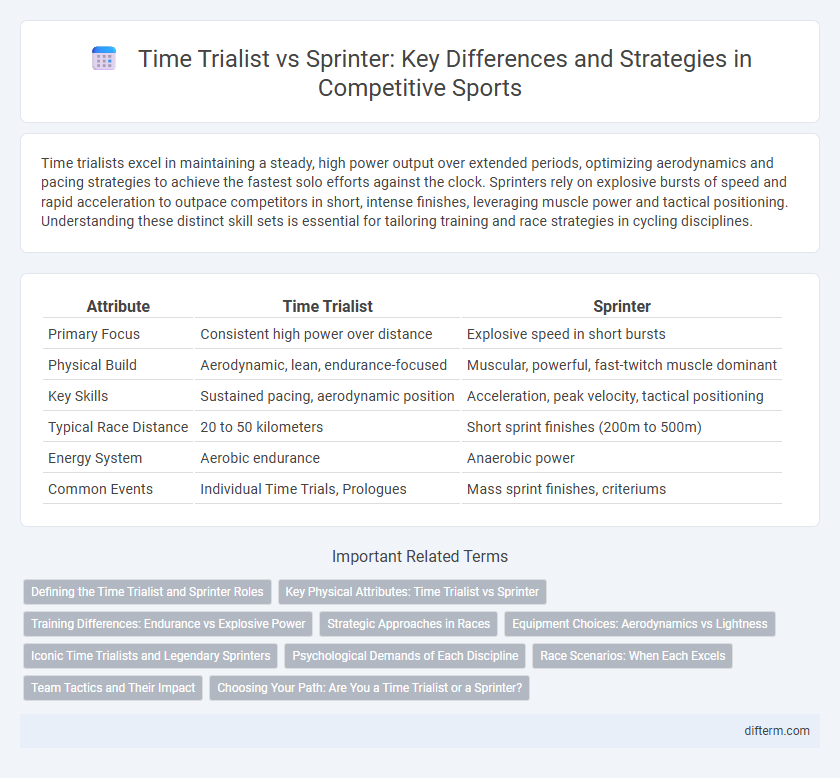Time trialists excel in maintaining a steady, high power output over extended periods, optimizing aerodynamics and pacing strategies to achieve the fastest solo efforts against the clock. Sprinters rely on explosive bursts of speed and rapid acceleration to outpace competitors in short, intense finishes, leveraging muscle power and tactical positioning. Understanding these distinct skill sets is essential for tailoring training and race strategies in cycling disciplines.
Table of Comparison
| Attribute | Time Trialist | Sprinter |
|---|---|---|
| Primary Focus | Consistent high power over distance | Explosive speed in short bursts |
| Physical Build | Aerodynamic, lean, endurance-focused | Muscular, powerful, fast-twitch muscle dominant |
| Key Skills | Sustained pacing, aerodynamic position | Acceleration, peak velocity, tactical positioning |
| Typical Race Distance | 20 to 50 kilometers | Short sprint finishes (200m to 500m) |
| Energy System | Aerobic endurance | Anaerobic power |
| Common Events | Individual Time Trials, Prologues | Mass sprint finishes, criteriums |
Defining the Time Trialist and Sprinter Roles
Time trialists excel in sustained, high-power efforts over extended distances, maintaining aerodynamic positions to minimize drag and optimize speed against the clock. Sprinters specialize in explosive bursts of acceleration, utilizing fast-twitch muscle fibers and tactical positioning to dominate short, intense race finishes. Both roles demand distinct physiological attributes and training approaches tailored to their unique demands in competitive cycling.
Key Physical Attributes: Time Trialist vs Sprinter
Time trialists exhibit exceptional aerobic capacity, sustained power output, and efficient energy management, enabling prolonged high-intensity efforts over extended distances. Sprinters, in contrast, possess explosive muscle strength, rapid acceleration, and anaerobic power crucial for short bursts of maximum speed. The contrasting muscle fiber composition--predominantly slow-twitch fibers in time trialists versus fast-twitch fibers in sprinters--defines their specialized performance capacities.
Training Differences: Endurance vs Explosive Power
Time trialists focus their training on endurance, emphasizing sustained power output and aerobic capacity through long, steady rides and interval sessions to optimize pacing and energy management. Sprinters prioritize explosive power development, incorporating high-intensity sprints, resistance training, and plyometrics to maximize fast-twitch muscle fiber recruitment and peak acceleration. These distinct training regimens reflect the physiological demands of maintaining consistent speed over time versus delivering short bursts of maximum velocity.
Strategic Approaches in Races
Time trialists prioritize steady pacing and aerodynamic efficiency to maintain consistent high speed over long distances, often controlling effort to prevent early fatigue. Sprinters focus on energy conservation throughout the race, positioning themselves strategically in the peloton before unleashing explosive power during the final meters. Tactical positioning and timing are crucial for sprinters, while time trialists rely on maintaining optimal cadence and minimizing wind resistance.
Equipment Choices: Aerodynamics vs Lightness
Time trialists prioritize aerodynamic equipment such as aero helmets, deep-section wheels, and skinsuits to minimize wind resistance and maximize speed over sustained efforts. Sprinters focus on lightweight components, including carbon fiber frames and minimalistic, lightweight wheels, to enhance explosive power and rapid acceleration. Optimizing equipment choices aligned with the specific demands of time trials or sprints significantly impacts competitive performance in cycling disciplines.
Iconic Time Trialists and Legendary Sprinters
Iconic time trialists such as Fabian Cancellara, Tony Martin, and Bradley Wiggins have dominated individual races against the clock with unparalleled consistent power output and aerodynamic efficiency. Legendary sprinters like Mark Cavendish, Eddy Merckx, and Mario Cipollini are celebrated for their explosive acceleration, tactical positioning in the peloton, and sprinting prowess in the final meters. The distinct skill sets of time trialists and sprinters highlight the contrasting demands of endurance versus burst speed in professional cycling.
Psychological Demands of Each Discipline
Time trialists require intense mental focus and sustained motivation to maintain optimal pacing over prolonged periods, often battling isolation and monotony. Sprinters face high-pressure decision-making demands, needing rapid reactions and explosive confidence to execute perfect timing in chaotic, high-stakes finishes. The psychological resilience in time trials centers on endurance and self-discipline, while sprinters rely heavily on acute situational awareness and aggressive mindset control.
Race Scenarios: When Each Excels
Time trialists dominate in individual races against the clock, excelling in long, flat courses where sustained power and aerodynamic positioning are crucial. Sprinters shine in mass-start races with unpredictable dynamics, leveraging explosive speed to surge ahead in short, intense final sprints. In stage races, time trialists gain time advantages on solo efforts, while sprinters target flat stages with bunch finishes to secure stage wins.
Team Tactics and Their Impact
Time trialists excel in maintaining consistent power output over long distances, enabling teams to set a strong pace and control breakaways effectively. Sprinters rely on strategic positioning and drafting within the peloton, requiring teammates to execute lead-outs that conserve energy and maximize sprinting potential. Team tactics blend these strengths by protecting sprinters during flat stages while utilizing time trialists to dominate time trial segments and support overall race strategy.
Choosing Your Path: Are You a Time Trialist or a Sprinter?
Time trialists excel in sustained power output and aerodynamic positioning, enabling them to maintain high speeds over long distances, making them ideal for individual races against the clock. Sprinters possess explosive acceleration and fast-twitch muscle fibers that allow rapid bursts of speed in short distances, dominating flat finishes and intense final sprints. Understanding your strengths in endurance versus burst power helps determine whether to specialize as a time trialist or sprinter in competitive cycling.
Time trialist vs sprinter Infographic

 difterm.com
difterm.com